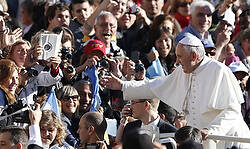Like many throughout the world, I've seen the pictures now materializing on Facebook, Buzzfeed and other sites -- the pictures of Pope Francis praying with and hugging a man apparently afflicted with neurofibromatosis, a genetic disorder that causes tumors to grow on nerve tissue. The images are arresting, and it's easy to understand why so many claim to have been moved to tears.
As I reflected on Pope Francis's embrace, I thought about how much this Pope is in the news, about how much he captivates through his actions. If Benedict was a man of text, Francis is a man of imagery. Today, for instance, people across the world are reflecting and commenting on an encounter that probably lasted no more than a minute or two. For his papacy, this has been the norm.
As I pondered this, I thought about what a shift the world has undergone, what a difference the modern era has made for the relationship between Catholics and the Pope. This transformation is captured succinctly in A History of the Popes: From Peter to the Present, by the great Jesuit historian Fr. John O'Malley. There, he writes:
The history of the popes is not a history of Catholicism, which is a much, much bigger reality. The popes are only a part of that history. We might easily confuse the two because, especially for the past hundred years, the papacy has played a larger role in Catholics' self-definition than ever before. This new preeminence is due to many factors, but among them the modern means of communication like radio, television, and now the Internet are especially important. In the year 1200, for instance, perhaps 2 percent of the population knew there was such an institution as the papacy or believed it had anything significant to do with their religion. How would they have known about it? The papacy was not mentioned in any creed, and it did not appear in any catechism until the sixteenth century.
Only 2 percent in the year 1200? It's a remarkable historical fact. Today, the whole world knows there's a pope, and for many Catholics, the papacy plays an essential role in their understanding of Catholicism. What are we to make of this shift? I suppose it depends on whom one asks, but if a picture is worth a thousand words, today it's a very good thing.








